Connecting state and local government leaders
A $31 million wildlife conservation project is taking shape on land in eastern Kentucky that includes the site of the first mountaintop removal coal mine in the state.
Bumping along in his pickup truck on the rutted, dirt roads carved across a tract of former coal mine land near Pineville, Kentucky, David Ledford describes the wildlife refuge he hopes to develop here over the next two years.
To an uninformed visitor, the site appears as shrubby, grass-covered plateaus and hills, offering a view for miles of mountains and ridges. But it is a scarred landscape. The natural contours were ripped away by mining that Ledford says took place between the 1970s and 1990s.
The Appalachian Wildlife Center, as the planned 12,000-acre facility is known, would cost about $31 million to get up and running. It would be home to dozens of elk and would also provide a habitat for birds, particularly those threatened by the loss of grasslands elsewhere.
Ledford envisions a place that’s like “a little Smithsonian Institute,” set in coal country, that would draw tourists from places like Knoxville, Tennessee, Louisville, Kentucky and Cincinnati. In addition to a loop road and walking trails for viewing elk, there would be opportunities for bird watching and stargazing. The site would be intended as a hub for wildlife research as well.
Projections, according to Ledford, show the center by its fifth year in operation could lure 638,000 visitors and bring $124 million of spending each year to a six-county area. This in a region battered economically by declines in the coal mining industry.
It was about about seven years ago when Ledford cofounded a nonprofit organization called the Appalachian Wildlife Foundation—the group responsible for the wildlife center project. “We think that we can do really innovative things for wildlife conservation, for habitat restoration, and for wildlife recreation and tourism,” he told Route Fifty in late March, during a visit to the refuge site.
Whether the wildlife center will spur tourism and spending in line with the foundation’s estimates won’t be known until after it is open.
But at a time when the coal industry in Appalachia is in flux, the project highlights important questions about what will happen with thousands of acres of old mine lands, and how those areas could fit into broader efforts to conserve the environment and boost the region’s economy.
“What we want to work on,” Ledford said, “is the afterlife of coal mines.”
‘Unfilled Niche’
A wildlife biologist, Ledford, 53, is a burly man, who hails originally from east Tennessee and talks enthusiastically about both hunting and songbird sightings. He previously worked for the Rocky Mountain Elk Foundation, a group started by hunters that focuses on elk conservation.
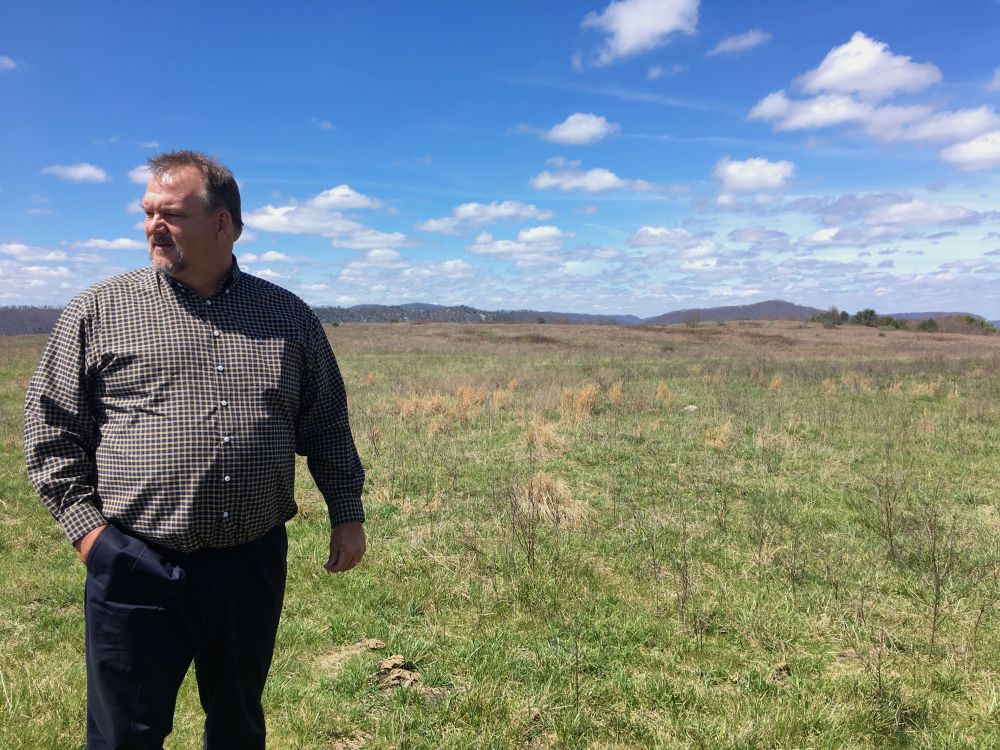
Over the past decade or so, he has taken on a role that he describes as somewhat unusual for those in the environmental conservation community, forging relationships within the coal industry and taking an interest in land that has been affected by mining.
It can be difficult, he explained, approaching mine operators and asking them to “do something for yellow-breasted chats,” a type of warbler known for its singing in the springtime, when “they’re dealing with dump trucks that are as big as a barn and drag lines and explosives.”
“You don’t just walk in and say ‘hey, I’m from the wildlife group and I’m here to help,’” he said.
He recalled how he told his boss at the Rocky Mountain Elk Foundation that “if there are going to be large numbers of elk in Appalachia, it’s going to be in these coal mine landscapes” and that there were missed opportunities for conservationists to work with the mining industry.
This was “an unfilled niche,” he said. But with these ideas not getting much traction within the organization, Ledford decided to leave and start the Appalachian Wildlife Foundation.
A portion of the wildlife center land is on the site of the first mountaintop removal coal mine in Kentucky, according to Ledford.
Mountaintop removal mining is a controversial practice that involves blasting apart mountaintops and ridges to reach seams of coal. It is often criticized for the destruction it causes to the environment and has also raised public health concerns.
There are tens of thousands of acres of “reclaimed” mine land in Kentucky, places like the wildlife center site. As mining was finished at the site, fill material was dumped onto the land and non-native grasses known for their resistance to erosion were planted.
In the past five years alone, 84,030 acres in Kentucky have undergone some form of reclamation work, according to the Kentucky Energy and Environment Cabinet.
‘The Birds Are Here’
Ledford acknowledges that many conservationists might take a doleful view of land marred by industry. But, he adds: “you can’t ignore these landscapes.” Bears, he points out, are among the animals that roam through the surrounding area. And the refuge land teems with birds.
As he drives, Ledford pauses mid-conversation to point out birds and identify their calls. Several harriers, a pileated woodpecker. The chirp of a towhee. Buffleheads, which are a sea duck, float on a pond near where the wildlife refuge’s visitor center is slated to be built.
Ledford at one point believes he’s heard a grasshopper sparrow. “They just came back,” he said. “That’s the first one I’ve heard this year.” He added: “That’s an imperiled bird right there. Because grassland sparrow habitat has disappeared. Well, they’re all over coal mines.”
Ron Rohrbaugh, is assistant director of the department of conservation science at the Cornell Lab of Ornithology, in Ithaca, New York. Reclaimed mine lands do not play a huge role in conservation planning, he said, because of the limited overall amount of space they occupy.
But that does not mean they are unimportant.
"Those mines never regrow back into forest,” said Rohrbaugh. "What they do do, in many cases, is provide really good grassland habitat." And one of the fastest declining groups of birds in the U.S., Rohrbaugh explained, are those whose nesting habitat is grassland—the type of land at the planned wildlife center site.
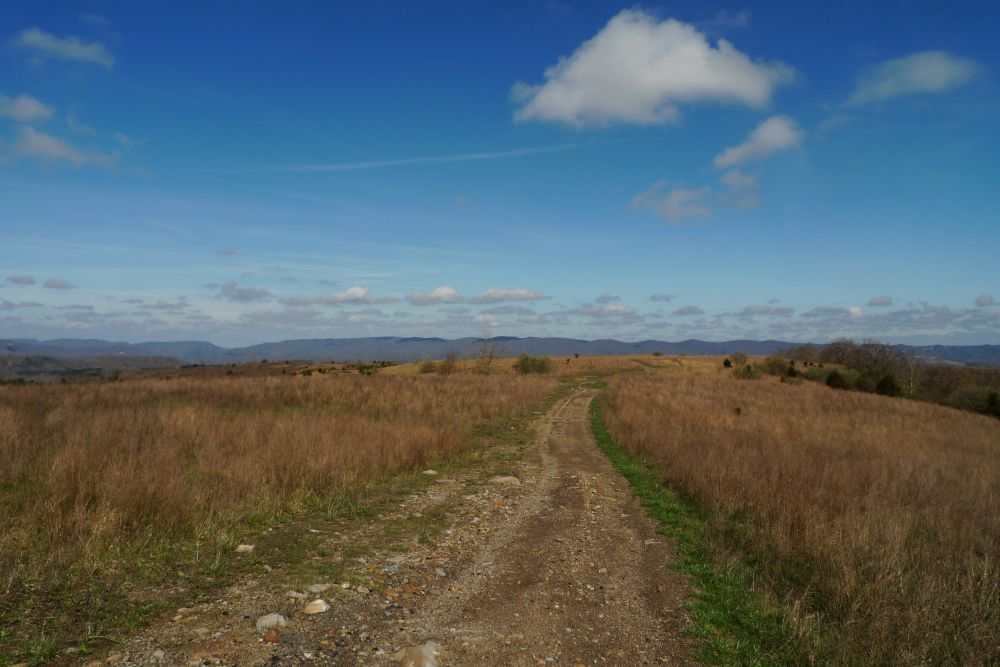
“Much of the prairie systems that supported these species in the Midwest are gone,” he said.
This is due in part to a rise in row crops, like corn, where the birds do not thrive.
"We've lost habitats that occur naturally,” Rohrbaugh said. Referring to the habitat reclaimed mine lands offer, he added that even though it is unnatural “it kind of supplements what we've taken away.”
It’s factors like this that help explain Ledford’s interest in reclaimed mine lands. “The birds are here. So do you just ignore them?” he said. “Or do you start looking at the ecological functions of what’s going on here and say ‘yeah, there’s some value.’”
The Elk
The main attraction at the wildlife center will be the elk, which can weigh 500 to 700 pounds. Bulls are known for their antlers and vocalizations, including “bugling” sounds.
An extinct subspecies of elk, native to the eastern U.S., disappeared from Kentucky around the mid-1800s, largely due to habitat loss and overhunting, according to the state’s fish and wildlife department.
It was over a century later, in 1997, when a program began to release a wild, free-ranging herd of Rocky Mountain elk, many of them from Utah, into the commonwealth. Kentucky’s estimated elk population has grown to roughly 11,000, from close to 4,000 in 2003, state figures show.
Ledford pointed out that even though there are thousands of elk in the state there are not many opportunities to see them. A lack of access to mining land is one factor that makes viewing difficult. Hunting, meanwhile, has thinned the numbers of elk on accessible public land.
People have turned out to view the animals elsewhere.
About 550 miles northeast of where the Appalachian Wildlife Center is planned is the Elk Country Visitor Center, near Benezette, Pennsylvania. It offers a chance for people to glimpse elk in the wild. Since the visitor center opened in 2010, the number of yearly visitors has risen to over 350,000, from about 70,000.
Ledford said the Appalachian Wildlife Foundation has plans to relocate about 200 elk on the wildlife center property between now and when it is scheduled to open in June 2019.
No hunting of the animals would take place on the wildlife center grounds—at least initially.
The center would provide a “source herd” for other states looking to establish elk populations. This means elk would be moved to limit the size of the center’s herd. Ledford did not rule out hunts in future years if the herd grows too large and demand for the animals in other places is low.
‘Hey, That’s an Industrial Park’
Roughly 11,500 acres of the planned wildlife center site are being leased from Asher Land and Minerals, a private firm. The company is headquartered in Kentucky. It owns around 40,000 acres of land, which it leases for coal, oil, gas and timber production and recreational uses.
Ledford did not want to say the dollar amount for the lease, but said, “it’s a very good deal” and that the price would be tied to visitation, going up as the number of visitors rises.
The foundation closed a deal last August for the purchase of about another 500 acres of land from the Pine Mountain Regional Industrial Development Authority. The authority acquired the property in 2004 and tried to develop it into an industrial park. No businesses ever located there.
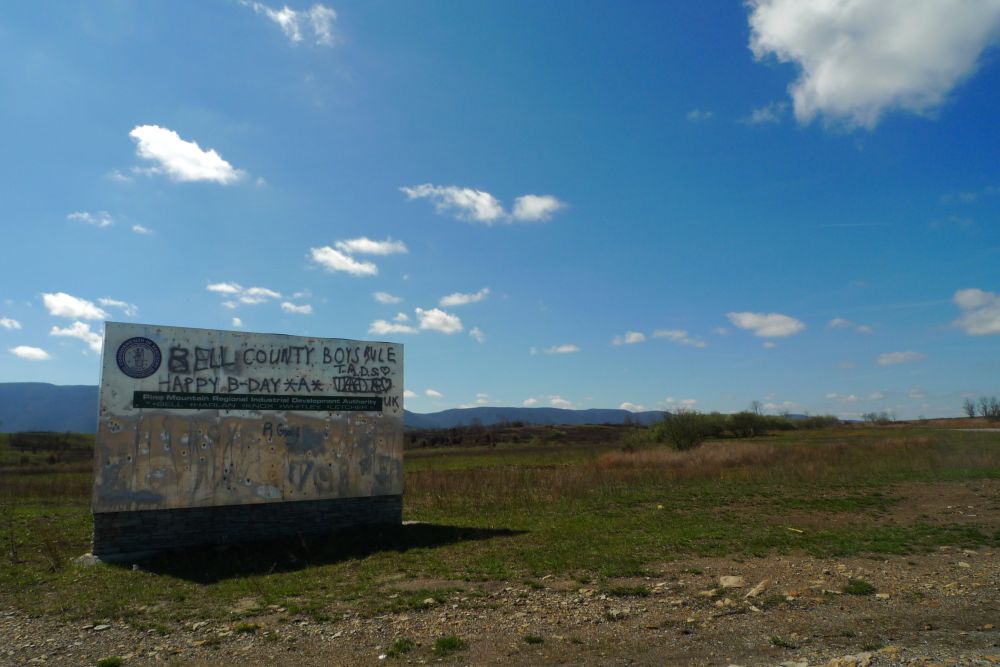
A sign the authority left behind is pocked with bullet holes and spray painted with graffiti. Ledford says he has a photo of it with cows grazing in the background.
When he first began working to acquire the land from the industrial development authority, he said there was some pushback in the community. “They said, ‘hey, that’s an industrial park, we’re supposed to put a manufacturing facility up there, not some damn petting zoo.’”
After sharing the visitor projections and making a case that the wildlife center could help the area’s economy, Ledford said some of the criticism toward the project died down.
‘Cautiously Optimistic’
Bell County, where the wildlife center would be located, has about 27,000 people. It is wedged into the far southeast corner of Kentucky, on the border with Tennessee and Virginia, and encompasses part of the Cumberland Gap National Historical Park.
Coal mines in this region have shed jobs since the early 1980s.
There were 37,505 coal mining jobs in eastern Kentucky in 1981, according to state figures. By early 2009, about 15,600 remained. And, by late last year, average annual coal mine employment in eastern Kentucky had dropped to around 3,800.
About 44 percent of the population in Bell County was in poverty between 2011 and 2015, according to U.S. Census Bureau figures. The unemployment rate was roughly 9 percent in March, about double the national rate at that time.
Tom Sexton is an organizer for the Sierra Club in eastern Kentucky and works on economic development initiatives in the region. He said he was “cautiously optimistic” about the wildlife center’s prospects. “I hope it’s tremendously successful,” he said.
But Sexton voiced some skepticism as well.
He likened the project to previous large, one-shot investments in parts of eastern Kentucky, like prisons, which have had a limited effect boosting the economy as a whole in his view.
“I’m not persuaded that there are any market-based solutions that are going to turn this thing around down here,” he said, referring to region’s economic plight.
His favored option for investment in east Kentucky would be a federal program, focused on developing energy sources like wind or solar and, in turn, creating new jobs.
“I think that what we need is a new, New Deal,” Sexton said, making a reference to the Great Depression-era federal program, which involved the establishment of agencies like the Works Progress Administration and the Civilian Conservation Corps to provide jobs.
'Sell Hotdogs and Hamburgers?'
Ledford said that much of the blowback he gets about the center these days is from locals who say they don’t have a place to ride their ATVs anymore. Some residents have continued visiting the property in recent months, even though it is supposed to be off limits.
Brian Hoskins was riding an ATV on the land on an afternoon in late March. Ledford encountered him on one of the roads. The young man was headed out fishing with his father and sister, who followed just behind him in a pickup truck.
Ledford didn’t run them off. He stopped to chat—an ambassador for his project.
“I believe I’d rather pay to come up here and fish and ride than look at elk,” Hoskins said.
“If you’re an employee here, if you work here, and you’re worth five cents, you might get some special treatment,” Ledford said lightheartedly.
After talking for a few minutes about some cows that died one winter on the property, how many elk the land could support, and a local logging operation, Ledford got out of his truck and gave the trespassers a brochure that described the wildlife refuge.
He told them about how there will be a museum, a theater, a gift shop and a restaurant.
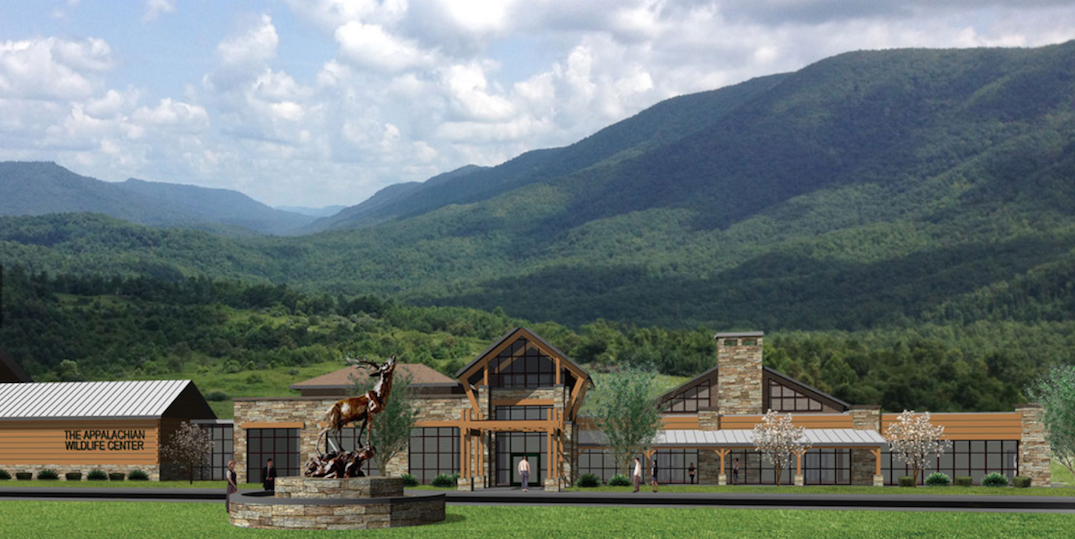
“The whole cash flow model is going to be built off of people coming here and spending money and then going home,” Ledford added. “They’re going to come down here and spend money and pay to see things that you guys take for granted because you live off the side of the ridge.”
Hoskins pushed back.
“What’s that going to do? Sell hotdogs and hamburgers?”
Ledford countered by saying that if tourism takes off in the area, it could lead to not only service jobs, but also construction jobs building new hotels and restaurants. And, he said, the wildlife center itself would be hiring, with an entry level wage of $14 per hour.
Asked if he’d take a job that paid that amount, Hoskins replied: “why sure.”
As the conversation ended, Ledford sent the family on their way with a cordial warning. “Good to see you, y’all go fishing,” he said. “Once I get them gates up, I better not catch you up here.”
Looking Ahead
The Appalachian Wildlife Foundation has raised about $16.4 million for the wildlife center.
That amount includes $12.5 million from a federal Abandoned Mine Land Reclamation Program pilot project. Another $1.8 million grant came via the Appalachian Regional Commission, an independent federal agency focused on economic development in parts of 13 states.
The project has attracted non-federal contributions as well, Ledford said, including $500,000 from “one of the godfathers of the coal industry” who wishes to remain unnamed, $100,000 from the Bell County Tourism Commission and smaller checks.
Revenue for the center would come from a number of sources, including an entry fee that will average around $13, and sales at the gift shop and restaurant.
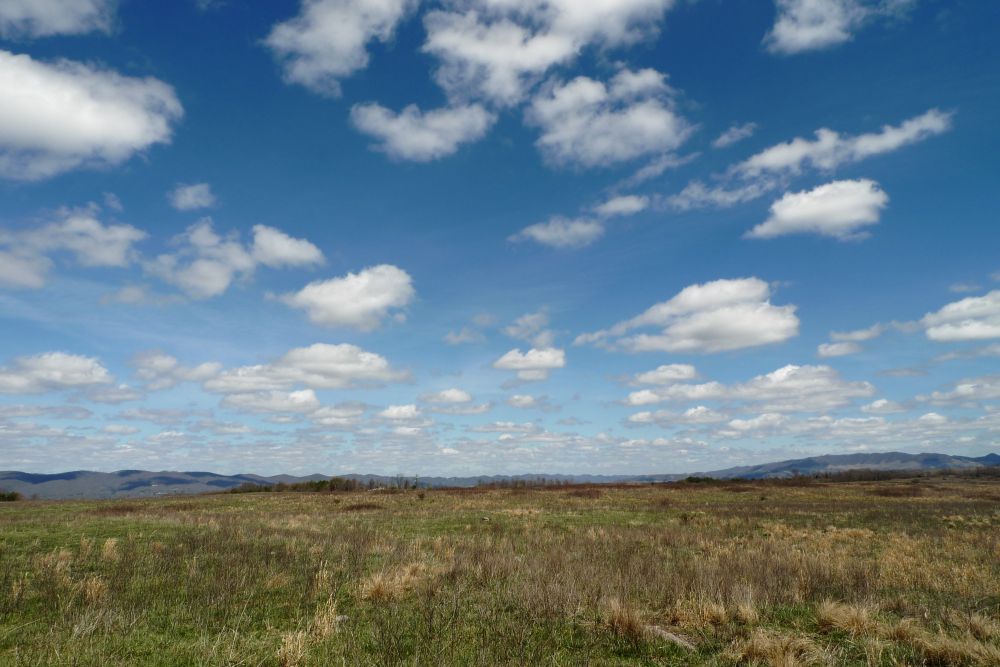
The goal is to break ground on the project sometime between December and next February.
Ledford has in recent weeks overseen controlled burns as part of an effort to clear away overgrown thickets and non-native beds of grass. There are plans to plant orchard grass, sunflowers and other vegetation that will serve as “kind of a salad bar mix for elk.”
Looking ahead there's also a possibility of experimenting with growing fruit trees and raising honeybees on the property. In addition to grassy reclaimed mine lands, the site has about 7,000 to 8,000 acres of woodlands, which Ledford said he had not really explored yet.
Standing near a dead set of overhead power lines that once provided electricity to the mining operation that forever altered the land, Ledford took stock of the surroundings.
“You could look around, see 200 elk, and never get within a quarter mile of one,” he said. “It’ll be gorgeous.”
Bill Lucia is a Senior Reporter for Government Executive’s Route Fifty and is based in Washington, D.C.

NEXT STORY: The Catch-22 ‘Sanctuary Cities’ Face Under Newly Signed Texas Law




